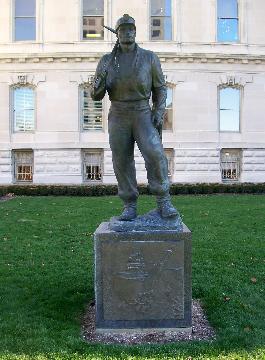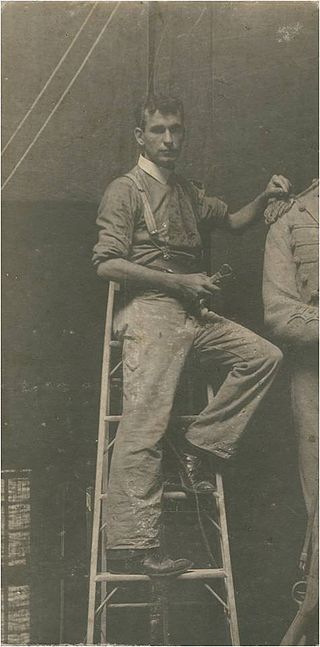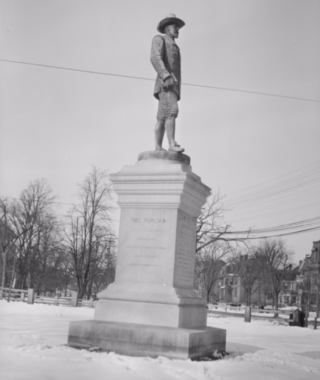
Daniel Chester French was an American sculptor of the late nineteenth and early twentieth centuries. He is best known for his 1874 sculpture The Minute Man in Concord, Massachusetts, and his 1920 monumental statue of Abraham Lincoln in the Lincoln Memorial in Washington, D.C.

The Goddess of Democracy, also known as the Goddess of Democracy and Freedom, the Spirit of Democracy, and the Goddess of Liberty, was a 10-metre-tall (33 ft) statue created during the 1989 Tiananmen Square protests. The statue was constructed over four days out of foam and papier-mâché over a metal armature and was unveiled and erected on Tiananmen Square on May 30, 1989. The constructors decided to make the statue as large as possible to try to dissuade the government from dismantling it: the government would either have to destroy the statue—an action which would potentially fuel further criticism of its policies—or leave it standing. Nevertheless, the statue was destroyed on June 4, 1989, by soldiers clearing the protesters from Tiananmen square. Since its destruction, numerous replicas and memorials have been erected around the world, including in Hong Kong, San Francisco, Washington, D.C., and Vancouver.

Harvard Square is a triangular plaza at the intersection of Massachusetts Avenue, Brattle Street and John F. Kennedy Street near the center of Cambridge, Massachusetts, United States. The term "Harvard Square" is also used to delineate the business district and Harvard University surrounding that intersection, which is the historic center of Cambridge. Adjacent to Harvard Yard, the historic heart of Harvard University, the Square functions as a commercial center for Harvard students, as well as residents of western Cambridge, the western and northern neighborhoods and the inner suburbs of Boston. The Square is served by Harvard station, a major MBTA Red Line subway and a bus transportation hub.

John Henry Foley, often referred to as J. H. Foley, was an Irish sculptor, working in London. He is best known for his statues of Daniel O'Connell in Dublin, and of Prince Albert for the Albert Memorial in London and for a number of works in India.

Randolph Rogers was an American Neoclassical sculptor. An expatriate who lived most of his life in Italy, his works ranged from popular subjects to major commissions, including the Columbus Doors at the U.S. Capitol and American Civil War monuments.

Cambridge Common is a public park and National Historic Landmark in Cambridge, Massachusetts, United States. It is located near Harvard Square and borders on several parts of Harvard University. The north end of the park has a large playground. The park is maintained by the Cambridge Department of Public Works.
Igor Fokin was a Russian puppeteer and street performer. He learned his craft in his hometown of St. Petersburg. He moved from the former Soviet Union to Cambridge, Massachusetts, in the United States, in 1993. He was able to bring his wife and son over in 1994, and was also granted a visa which allowed him to continue to live and perform in the United States. He performed puppet shows on summer evenings on street corners in Cambridge. He used wooden marionettes set to traditional Russian music. The marionettes were carved and painted by him, and he also sewed the marionettes' clothing. In 1996, he performed shows as part of the festivities at the Summer Olympics in Atlanta, Georgia. He died early in the morning from heart failure on September 21, 1996, at the age of 36, just a few hours after returning home from a show in Harvard Square.
Konstantin Simun was a Russian sculptor living and working in Boston, United States. He was born in Saint Petersburg, Russia in 1934. He is most well known for his large-scale monuments, including "Broken Ring", a monument to the "Road of Life" on Lake Ladoga, near Saint Petersburg, and "Totem America," exhibited for a decade at DeCordova Museum and Sculpture Park. He was a recipient of awards from the International Dyagilev Prize "For Devotion to Art", the Ludwig Vogelstein Foundation, and the Pollack-Krasner Foundation.

The James Cardinal Gibbons Memorial Statue is a public artwork by Leo Lentelli, located at the Shrine of the Sacred Heart, 16th Street and Park Road Northwest, Washington, D.C.

Coal Miner is a public artwork by Polish American artist John J. Szaton (1907–1966) which is located in two US State capitals; the original, commissioned in 1963 in Springfield, Illinois, as well as a copy on the west lawn of the Indiana State House in Indianapolis The statues commemorate coal miners who had lost their lives in those states' mining industry. The 7-foot (2.1 m) tall statue rests on a 3-foot (0.91 m) square, granite base supported by a cement foundation that is 4–6 inches (100–150 mm) thick.

The fourth plinth is the northwest plinth in Trafalgar Square in central London. It was originally intended to hold an equestrian statue of William IV, but remained empty due to lack of funds. For over 150 years, its use was debated; in 1998, the Royal Society for the encouragement of Arts, Manufactures and Commerce (RSA) commissioned three contemporary sculptures to be displayed temporarily on the plinth. Shortly afterwards, Chris Smith, Secretary of State for Culture, Media and Sport, commissioned Sir John Mortimer to seek opinions from public art commissioners, critics and members of the public as to its future. Mortimer's final report recommended that there continue to be a rolling programme of commissioned temporary artworks rather than settle permanently on one figure or idea.

John Albert Wilson was a Canadian sculptor who produced public art for commissions throughout North America. He was a professor in the School of Architecture at Harvard University for 32 years. He is most famous for his American Civil War Monuments: the statue on the Confederate Student Memorial on the campus of the University of North Carolina, Chapel Hill, and the Washington Grays Monument in Philadelphia.

John Harvard is a sculpture in bronze by Daniel Chester French in Harvard Yard, Cambridge, Massachusetts, honoring clergyman John Harvard (1607–1638), whose deathbed bequest to the "schoale or Colledge" recently undertaken by the Massachusetts Bay Colony was so gratefully received that it was consequently ordered "that the Colledge agreed upon formerly to bee built at Cambridg shalbee called Harvard Colledge." There being nothing to indicate what John Harvard had looked like, French used a Harvard student collaterally descended from an early Harvard president as inspiration.

Large Four Piece Reclining Figure 1972–73 is a bronze sculpture by Henry Moore. Approximately 4 metres (13 ft) long, the sculpture was made an edition of seven full size casts, all cast by the Hermann Noack foundry in Berlin.

The John Bridge Monument, in the northeast corner of the Cambridge Common in Cambridge, Massachusetts, was given by Samuel James Bridge in honor of his ancestor John Bridge (1578–1665) and sculpted by Thomas R. Gould.

The Emancipation Memorial, also known as the Freedman's Memorial or the Emancipation Group was a monument in Park Square in Boston. Designed and sculpted by Thomas Ball and erected in 1879, its sister statue is located in Lincoln Park in the Capitol Hill neighborhood of Washington, D.C. The Boston statue was taken down by the City of Boston on December 29, 2020, following a unanimous vote from the Boston Art Commission on June 30 to remove the memorial.















